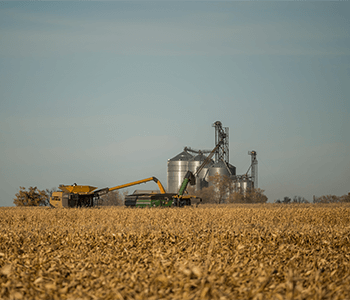MANAGING CORN HARVEST
Nov 05, 2019

Cooler and wetter than normal conditions continue to influence corn development and dry down. The 2019 harvest will be a balancing act of managing field dry down, drying costs, harvest losses in a standing crop and harvest efficiency.
While corn growing degree days can predict the rate of field drying, they don’t reflect all drying parameters, like potential evapotranspiration (PET). According to data from the U2U Growing Degree Unit (GDU) calculator, the Aberdeen area accumulated less than 60 GDUs in October, compared to an approximate “normal” of 140. Cloudy October weather further reduced drying and PET. Expect these issues following a low GDU year: higher moisture corn, with slower dry down, and possible lower field test weights.
Additional field dry down items to note:
While corn growing degree days can predict the rate of field drying, they don’t reflect all drying parameters, like potential evapotranspiration (PET). According to data from the U2U Growing Degree Unit (GDU) calculator, the Aberdeen area accumulated less than 60 GDUs in October, compared to an approximate “normal” of 140. Cloudy October weather further reduced drying and PET. Expect these issues following a low GDU year: higher moisture corn, with slower dry down, and possible lower field test weights.
Additional field dry down items to note:
- Corn usually loses around 2.5 moisture pts/week in October, but that rate was much lower in 2019.
- November generally provides at best 1 pt/week dry down; the forecast of continued cold temperatures do not look favorable for significant drying.
- Normally, 25- 27% moisture corn by Nov. 1 will only reach 20 - 22% by Dec. 1; so some corn may not get below 20% this year.
- Consider field loss from plant lodging and ear drop. Good to excellent corn yields have been reported. But the crop is also relatively short on nitrogen, with nutrient mobilization from the plant to fill the ears.
- - So stalk strength will be a major concern. Walk fields and do a “push test” to measure standability. Bend plants 30-45 degrees off center, noting what percentage breaks or remains standing. Weak plants are prone to break in any significant wind event.
- - Test ear shank strength. Ear loss is yield loss, so test various fields for strength.
- Calculate harvest efficiency. Slowing the combine by 20% because of downed corn is a very significant cost, and offsets drying costs by a large amount. Fuel burned per hour is the same. This cost extends beyond the combine to grain handling and labor costs.
- Calculate in that the needed switch to #1 diesel as the temperature further drops is an additional cost.
- Leaving corn until spring is generally not a good idea.
- - Harvest losses are dependent on corn standability (expect lower than average), weather conditions (possible heavy snow events), wildlife, etc.
- - Given current widespread wet soil conditions, spring harvest may be even wetter, with significant delays or worse conditions.
- - Standing corn is a huge buffer between the atmosphere and soil; this hampers soil dry down and delays normal spring operations for the next crop.